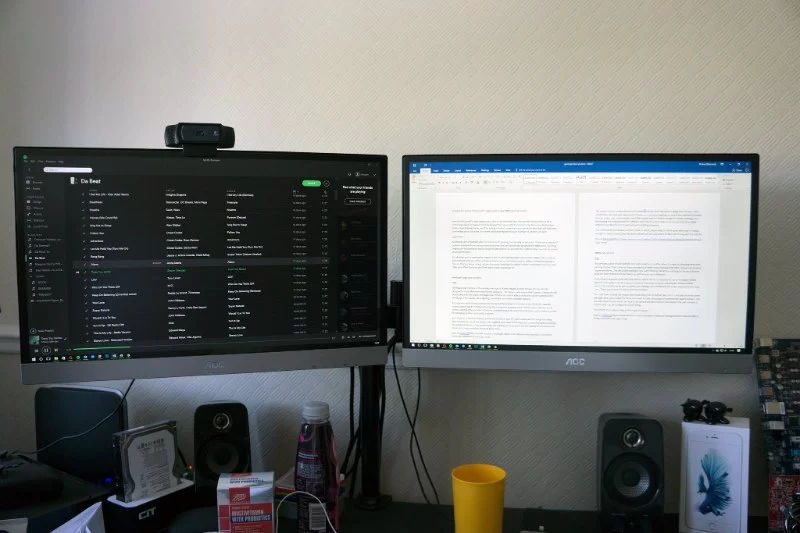- why-use-dual-monitors-for-windows-10-11
- what-you-need-to-get-started
- how-to-set-up-dual-monitors-on-windows-10
- how-to-set-up-dual-monitors-on-windows-11
- troubleshooting-common-dual-monitor-problems
- pro-tips-and-ergonomic-considerations
1. Why Use Dual Monitors for Windows 10/11
Whether you're working remotely, gaming, or managing a trading desk, dual monitors can drastically boost your productivity. On Windows 10 and 11, the operating systems are designed to handle multi-display setups seamlessly, allowing users to multitask, compare documents side by side, or keep email and chat visible while working on projects.
Recent studies show that people who use dual monitors complete tasks nearly 20–30% faster than those using a single screen. Just imagine editing video on one monitor while keeping your media bin on the other — it's a game-changer.
2. What You Need to Get Started
2.1 Compatible Hardware
Make sure your computer has the required ports: HDMI, DisplayPort, USB-C with video support, or even VGA if you're going old-school. Some laptops come with only one port but support a docking station or splitter to allow dual displays.
2.2 Proper Cables
Use the correct cables for each monitor — don't mix DisplayPort and HDMI unless you’re using an adapter. Signal integrity can be impacted by poor-quality cables, so it’s worth investing in branded or reviewed options.
2.3 Monitor Settings and Stand Placement
For ergonomics, the monitors should be level with your eyes and side-by-side without gaps. It’s common to place your primary screen directly in front of you and the secondary at a slight angle.
3. How to Set Up Dual Monitors on Windows 10
3.1 Plug in the Monitors
Connect both monitors to your PC or docking station. Windows 10 usually detects them automatically.
3.2 Open Display Settings
Right-click on the desktop and select “Display settings.” You’ll see a graphic showing monitor 1 and 2. If not, click “Detect.”
3.3 Arrange Your Screens
Click and drag the display icons to match the physical setup of your monitors. This ensures your mouse and windows move correctly between screens.
3.4 Choose Display Mode
Scroll to “Multiple displays” and select from:
- Extend: Treats each monitor as a separate screen.
- Duplicate: Shows the same thing on both screens.
- Second screen only: Turns off the primary screen.
3.5 Set Resolution and Orientation
Set the resolution for each monitor individually. Ideally, both should run at their native resolution to avoid blurry visuals.
4. How to Set Up Dual Monitors on Windows 11
4.1 The New Display Interface
Windows 11 has a more streamlined settings menu. Right-click the desktop → “Display settings” → Your monitors appear as numbered rectangles.
4.2 Adjust Scale and Layout
Click each monitor to adjust resolution, scale, and refresh rate. You can now even set different refresh rates per monitor, great for gamers using 144Hz+ panels.
4.3 Snap Layouts for Windows 11
Windows 11 introduced “Snap Layouts,” which work beautifully on dual monitors. Drag your windows to predefined sections across both screens for advanced multitasking.
5. Troubleshooting Common Dual Monitor Problems
5.1 Monitor Not Detected
Check the cable connection first. Then restart your system. Still stuck? Try updating your graphics drivers. Many users overlook this, but outdated drivers often cause detection issues.
5.2 One Screen Flickers or Is Dim
This might be a sign of cable failure or port incompatibility. Switch cables or test the monitor with another system to isolate the issue.
5.3 Incorrect Display Order
If your mouse moves in the wrong direction between screens, go to display settings and drag the monitor icons into the correct physical order.
5.4 Incompatible Refresh Rates
Ensure both monitors support the refresh rate you've selected. Some low-end models may not handle 75Hz or 120Hz properly.
6. Pro Tips and Ergonomic Considerations
6.1 Match Sizes for Best Comfort
Using monitors of drastically different sizes or resolutions can create a disjointed workflow. If possible, use two matching monitors or at least ones with similar specs.
6.2 Invest in Monitor Arms
Monitor arms not only clean up your desk space but also allow you to fine-tune the height and angle for better posture — crucial if you're working long hours from home.
6.3 Don’t Ignore Eye Health
Use blue light filters or software like f.lux to reduce eye strain. Also, take short breaks every hour to rest your vision.
If you’re having persistent trouble configuring your monitors, or need hardware upgrades, the team at Computer Repair can help with setup, compatibility diagnostics, and even workstation optimization to ensure you're getting the most out of your multi-monitor layout.






























